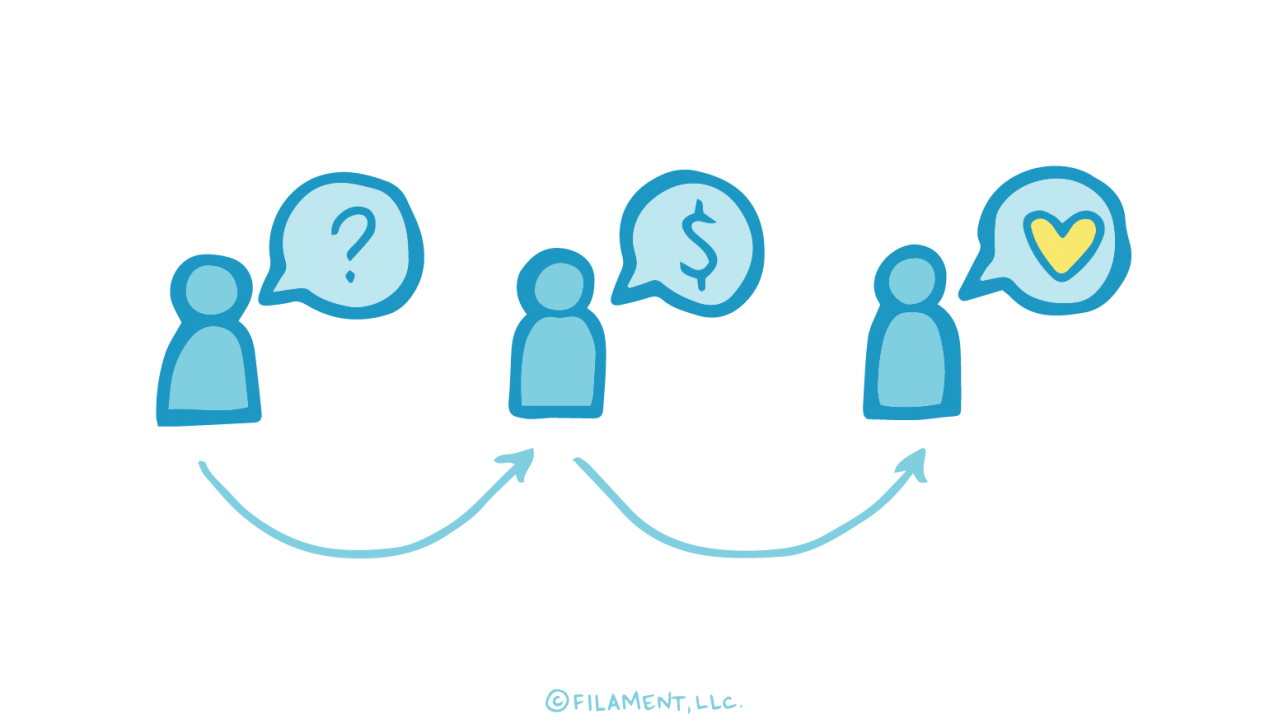We all know that part of a great content strategy is getting the right content to our target audiences at the right time. That means we need to define and identify the right time for our target audiences. We’re not just talking about what time of day they’re on their devices and different channels (though that’s important, too). What we’re considering today is the right time in terms of the buying cycle, i.e. how close members of your target audiences are to converting.
You can use the buying cycle to create targeted content that will be useful to your potential customers at each stage. The content you deliver to a person who’s completely unfamiliar with your products and services needs to be very different from the content you deliver to advocates of your brand—because their needs are different. Mapping your content onto the different stages of the buying cycle helps you get strategic about nurturing potential customers toward conversion.
So let’s look at the buying cycle and what kinds of content would be most useful at each point to help move your leads through the lifecycle stages:
Awareness
At the awareness stage, people have—that’s right—become aware of a potential problem or opportunity. The goal of your content at this stage is to attract potential customers via search engines and social media. You can reach that goal by creating shareable, memorable, and optimized content. What types of content are we thinking here? Here’s a list to consider:
- beginners’ guides
- eBooks
- blog posts (guides, tips, & lists)
- social media posts, tweets, etc.
- white paper
- article
- podcasts
- infographics
- memes
- press release
- curated articles
- competitions
- videos
Remember as you’re creating this content what it is you want your customers to do, i.e. what is the concrete action they need to take in order to move to the next stage. You might want follows, shares, comments or email subscriptions. This stage is not the place for overly salesy or product-focused content, but rather content that informs people about the problem in general.
Consideration
When people are in the consideration stage, they’ve clearly defined and given a name to the problem or opportunity ahead of them. Your goal then becomes to help them find a solution to their problem with the right product or service. You do that by creating content that highlights how your product or service could potentially solve that problem and further educate them about the problem and its solution.
It’s in this stage that you want to deliver your product descriptions. Your product descriptions need to speak to that specific pain point that your target audience has, explaining how your product or service addresses that pain point. Other types of useful content for this stage include the following:
- product reviews
- customer testimonials
- case studies
- buyer guides
- video demonstrations
- webinars
- tutorials
- guided tour
What’s the desired action you want potential customers to take? At the consideration stage, perhaps you want them to watch a video, attend a webinar or download a resource that showcases what you have to offer.
Decision
At the decision stage, your potential customer has defined the solution to their problem or opportunity. Your goal is to convince and convert. You do that providing evidence that shows why your product or service is the best choice and make it easy for them to understand the value you provide. It’s time for your sales pitch. A few types of content to consider:
- estimates
- free trials
- case studies
- testimonials
- consultation
- chat
- contact info
Advocacy
Your job doesn’t stop after a conversion. Oh, no. This is where you start the cycle over again by working to get returning customers and spread awareness about your brand. How? By creating shareable, memorable, optimized content. (Sound familiar?) Consider the following types of content for this objective:
- surveys
- email marketing
- newsletters
- feedback forms
- promotions, discounts & giveaways
- product recommendations
In the end, you want your customers to tell others about the great service or product they received from you and share your content.
You might have noticed that some types of content show up on more than one of the above lists. Some types on content can do double duty. Just make sure each piece of content addresses the needs your potential customers have at each of the stages its mapped onto.
In addition, mapping content onto your buying cycle is only half the picture. You’ll want to be sure you’re also targeting content according to specific characteristics of your target audiences. Use buyer personas to make that task simpler.
There are a lot of tools out there to help you visualize your content maps. We like this content mapping template from HubSpot. And don’t forget that a content mapping needs to go hand in hand with compelling user-focused content.
Check out Filament’s website for more information about how we can help you deliver the right content to the right people at the right time.



Comments (2)